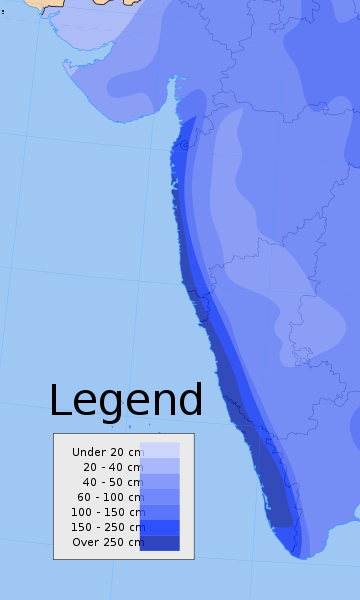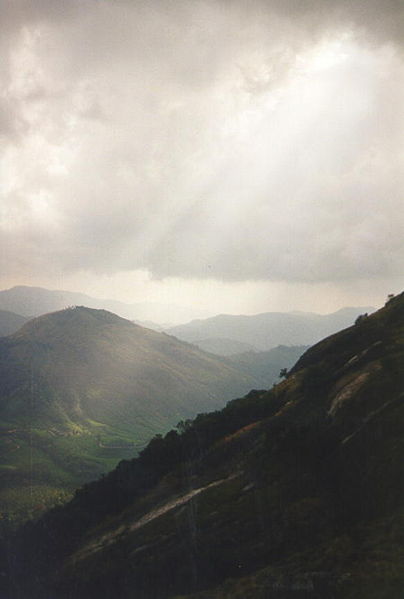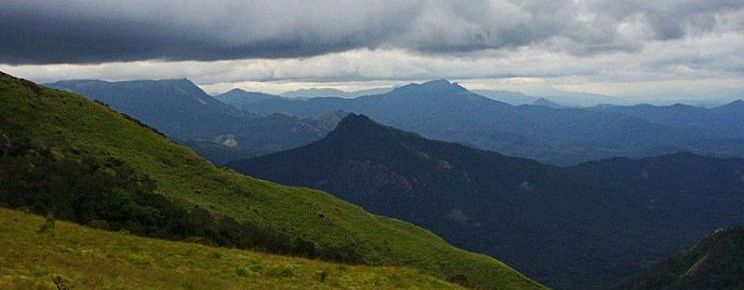Habitat
The holotype (specimen obtained for formal observation), an adult
female Nasikabatrachus sahyadrensis, was originally found
in Kattappana, Idukki district, Kerala, Western Ghats, India at 09º
45’ N, 77º 05’ E at an altitude of 900 meters by S. D. Biju and
Franky Bossuyt (Biju and Bossuyt, 2003). With this location as
a
 starting
point, continued research now indicates that N. sahyadrensis
is found to exclusively inhabit the Western Ghats of India from
Camels Hump Hill range in the north to the northern region of the
Agasthyamalai Hills in the southern Western Ghats at an elevation
range of 60 to 1100 meters above sea level (Zachariah et al. 2012).
The Western Ghats is a 1600 km long mountain range on the Indian
west coast known to have the highest biodiversity on Earth (Praschag,
2004). Tropical rainforests, with an annual rainfall of 3200mm
to 7500mm, cover most of the areas where N. sahyadrensis
sightings have been reported (Das, 2006). The Anamalai Hills
of the southern Western Ghats where N. sahyadrensis has
been studied typically have two monsoon seasons per year; one from
June to August, and another from December to May, with the most
recorded rainfall between August and June. Also, the average
temperature of the Anamalai region of the Western Ghats is 19-25ºC
(Raj et al. 2011). The conditions are typical of the tropical
rainforest habitat and play a crucial role in accommodating the
N. sahyadrensis life style.
starting
point, continued research now indicates that N. sahyadrensis
is found to exclusively inhabit the Western Ghats of India from
Camels Hump Hill range in the north to the northern region of the
Agasthyamalai Hills in the southern Western Ghats at an elevation
range of 60 to 1100 meters above sea level (Zachariah et al. 2012).
The Western Ghats is a 1600 km long mountain range on the Indian
west coast known to have the highest biodiversity on Earth (Praschag,
2004). Tropical rainforests, with an annual rainfall of 3200mm
to 7500mm, cover most of the areas where N. sahyadrensis
sightings have been reported (Das, 2006). The Anamalai Hills
of the southern Western Ghats where N. sahyadrensis has
been studied typically have two monsoon seasons per year; one from
June to August, and another from December to May, with the most
recorded rainfall between August and June. Also, the average
temperature of the Anamalai region of the Western Ghats is 19-25ºC
(Raj et al. 2011). The conditions are typical of the tropical
rainforest habitat and play a crucial role in accommodating the
N. sahyadrensis life style.
The wet soil of the tropical rainforest allows N. sahyadrensis to thrive as burrowers, living most of their
life underground; thus, they prefer habitats with moist, soft soil
that is easy to burrow through. Their legs, being unmodified
for jumping, are of no use for above ground living, making hard, dry
ground environments unfavorable. Also, the immense
biodiversity of the Western Ghats provides an environment that
houses the small, soil dwelling insects that compose the N.
sahyadrensis diet. Further, the monsoon seasons play a
large role in N. sahyadrensis breeding patterns. The
breeding season begins in late May just before the June to August
monsoon season begins in the Western Ghats, particularly on days
with much rainfall. The male N. sahyadrensis
vocalizes a mating call to the females through the soil during the
monsoon season; thus, it is suggested that increased humidity in the
soil promotes transmission of sound waves, providing optimal
conditions for the mating ritual to begin (Raj et al. 2011).
sahyadrensis to thrive as burrowers, living most of their
life underground; thus, they prefer habitats with moist, soft soil
that is easy to burrow through. Their legs, being unmodified
for jumping, are of no use for above ground living, making hard, dry
ground environments unfavorable. Also, the immense
biodiversity of the Western Ghats provides an environment that
houses the small, soil dwelling insects that compose the N.
sahyadrensis diet. Further, the monsoon seasons play a
large role in N. sahyadrensis breeding patterns. The
breeding season begins in late May just before the June to August
monsoon season begins in the Western Ghats, particularly on days
with much rainfall. The male N. sahyadrensis
vocalizes a mating call to the females through the soil during the
monsoon season; thus, it is suggested that increased humidity in the
soil promotes transmission of sound waves, providing optimal
conditions for the mating ritual to begin (Raj et al. 2011).
Go to Adaptation
